Barbara Shapiro: Weaver, Dyer, Basket Maker
Cathy Koos
I recently had the pleasure of Zooming a wonderful presentation by the renowned Barbara Shapiro. She gave this talk to a packed house for the Textile Arts Council at the Fine Arts Museum in San Francisco. In addition to the live talk, many of us at a distance joined in by Zoom.
Barbara has been a fiber artist for over 50 years. She studied comparative literature at UC Berkeley in the lively mid-60s and “totally missed what others were doing in fiber arts.”
“The possibility of change permeated Cal in the 60s.”
Barbara is advisor to the Textile Arts Council of the FAMSF and a past board member of Textile Society of America, and a member of a number of other guilds, including Friends of Fiber Arts International, which is now closed. She belongs to Black Sheep and Bay Area Basket Makers now. She teaches at workshops, conferences, and universities around the country. She has been a frequent contributor to The Surface Design Journal.
TIMELINE
1975 Brooklyn was the location of Barbara’s first weaving class. A cross-country move then landed Barbara in San Francisco. She was recipient of a loom owned by Alexander Calder’s sister in 1976, and then 1980 saw the acquisition of an 8-harness Gilmore loom. Soon, Barbara was designing and weaving garments for herself, for clients, and fashion shows.
By the mid-1980s, Barbara was ready to move on from yardage and garments, and she began studying with Candace Crockett at San Francisco State University. She concentrated on woven artwork for wall display, primarily in silk and shibori. Thus began her relationship with SF State as a volunteer TA (Teaching Assistant) for 25 years.
“My whole career became a continuum of exploration,” Barbara said. She found numerous international friends long the way including many friends in CNCH, and the Bay Area Basket Makers, where she learned coiling at a CNCH conference. In By 2004, baskets became her primary focus, along with various indigo projects. “Indigo continues to be a blue thread that often ties it all together!”
However, coiling soon took a toll on her hands, and Barbara moved into plaiting with cane, bamboo, and paper.
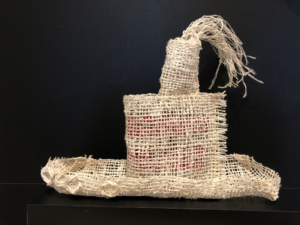
Figure 1San Francisco Bay tugboat seen from Barbara’s studio
INFLUENCES
Art in the time of Covid and its subsequent isolation proved to be an interesting time for Barbara. Current events now drove her work. A move to a new studio also proved valuable and helped her work. The huge Gilmore loom was replaced by a smaller loom. She sorted through all her archives and by March 2020 she was ready to work again. Covid’s very seclusion became a very productive time for Barbara.
Like many of us facing a move, Barbara found some UFO’s (UnFinished Objects). Most have been picked up, reworked, and completed.
Exploring hexagonally woven plaiting became a favored method as it allowed shaping and the application of a paper skin of used tea bags.
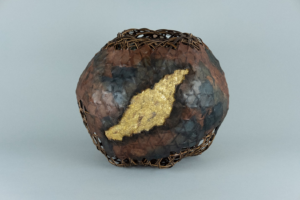
Figure 2Tukkun Olam, globe, tea bags
Tikkun Olam is a Hebrew word for “repair the world.” Barbara’s work reflects many of the world’s political and environmental concerns.
Indigo has also become a great influence on Barbara’s work. In her new studio, she has set up a Weck canning pot for her new indigo station.
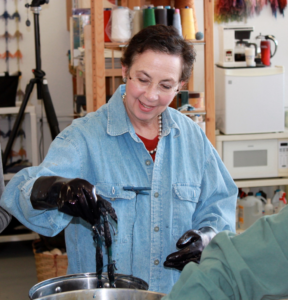
Figure 3 Barbara dipping indigo
Inspiration from Japan also drives new ideas, and Barbara joined the World Shibori Network Foundation where she is now a board member.
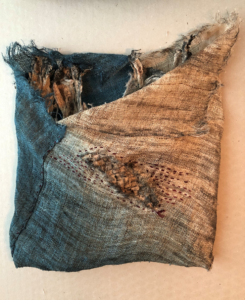
Figure 4 Japanes horn bag 1
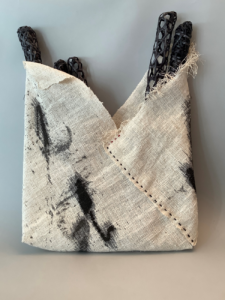
Figure 5 Japanese Horn Bag 2
Japanese Horn Bags have become a new form of expression, reflecting environmental challenges; the war in Ukraine; people fleeing conflict; and left/right leaning people.
Barbara also created a series of covered baskets for her Urns for Covid series honoring those we lost.
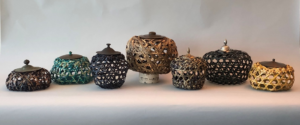
Figure 6 Urns for Covid
“Messy notebooks of ideas, projects completed, and UFOs” are kept private, except for one she shares.
The Textile Arts Council announced a tour to France in the fall which may be full; it will will include a stop in Lyon, the city famous for its weaving workshops. Contact TAC for more information. People can reach Barbara through her website at http://www.barbarashapiro.com
References
1 Magdalena Abakanowitz: https://www.tate.org.uk/whats-on/tate-modern/magdalena-abakanowicz ;
https://www.tate.org.uk/art/artists/magdalena-abakanowicz-1009
You can learn more about Barbara’s her at Barbara’s website at www.barbarashapiro.com